Houston Botanic Garden’s surprising cactus garden and more – part 2
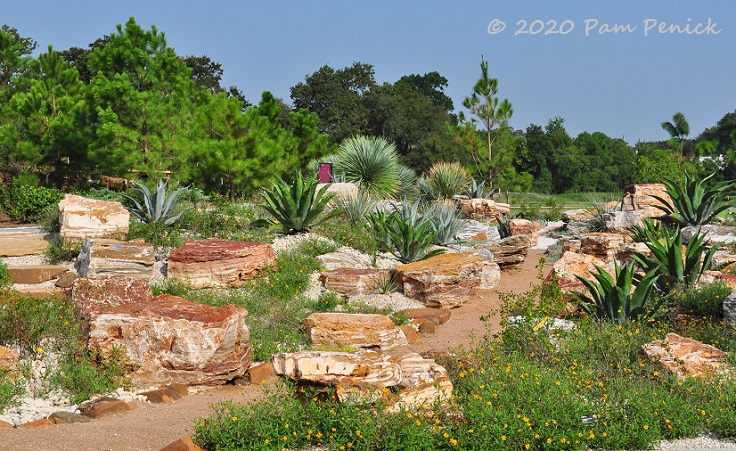
During my inaugural visit to the brand-new Houston Botanic Garden last weekend, my eyes widened when I rounded a bend and saw this — a rocky garden of agave, yucca, and cactus. After all, this is Houston, city of sauna-like summers and 50 inches of annual rainfall. You just don’t see agaves or xeric plants in great numbers in Houston.
Naturally I loved it, agave freak that I am.
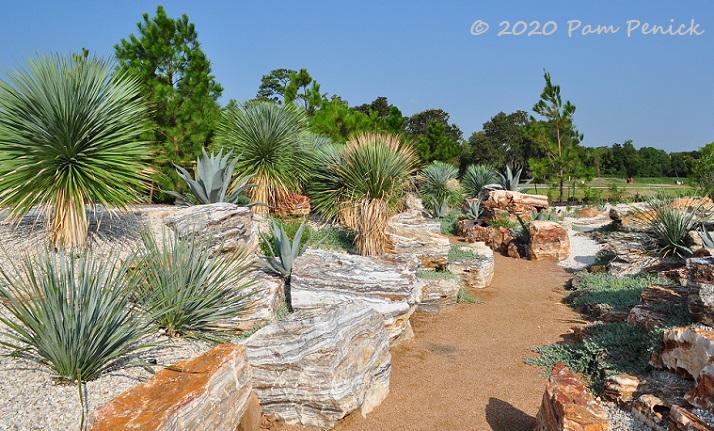
It’s called Arid Valley. So what do you think? Is this the garden version of an uncanny valley? Hah, no. It looks quite authentic, actually. But as my daughter pointed out, it feels more like a canyon with those stratified rock walls. So we’ve renamed it Desert Canyon in our heads — sorry, HBG!
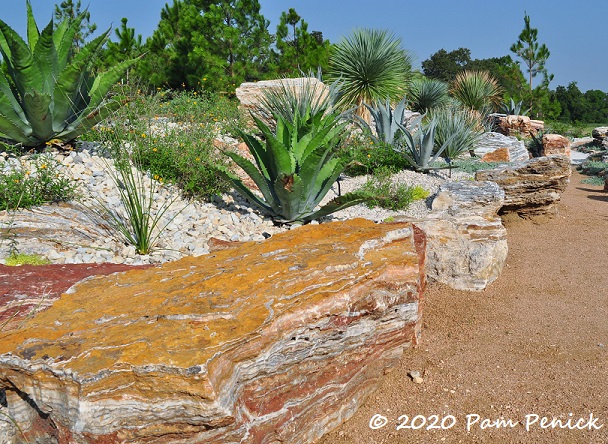
Sunset-hued Arizona onyx boulders stacked into low walls are backfilled with gravelly soil for dry-loving plants.
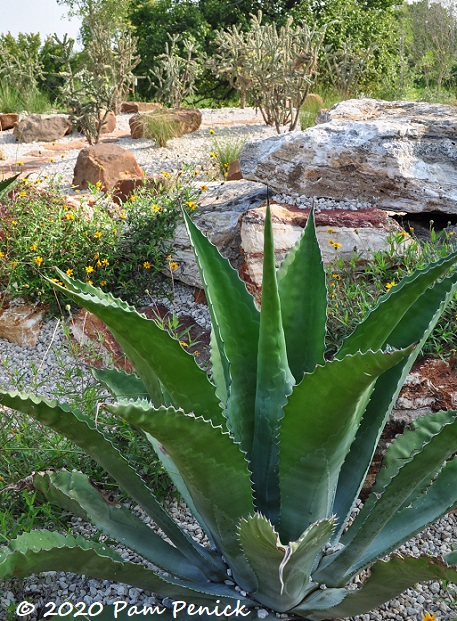
‘Jaws’ agave showing off its toothy leaves
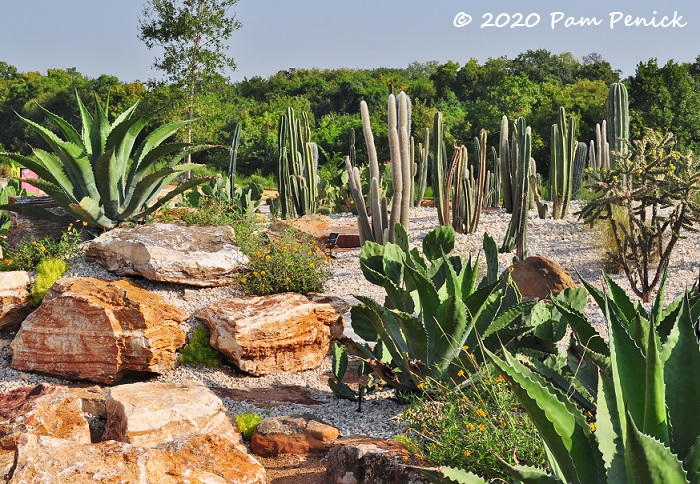
They even have torch cactus, which I never see in Austin. Houston is a hardiness zone warmer than Austin (in addition to being much rainier), which must make this possible.
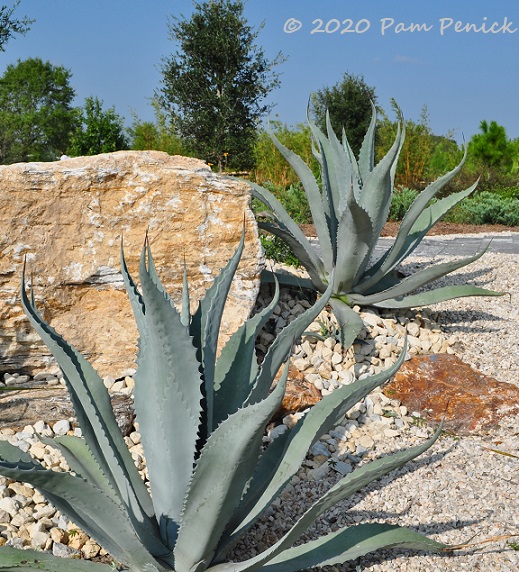
This matte blue beauty is Agave americana ‘Kerbey Lane’. I’ve been to Austin’s original Kerbey Lane Cafe many times but never knew an agave is named for it. What’s the story, I wonder?
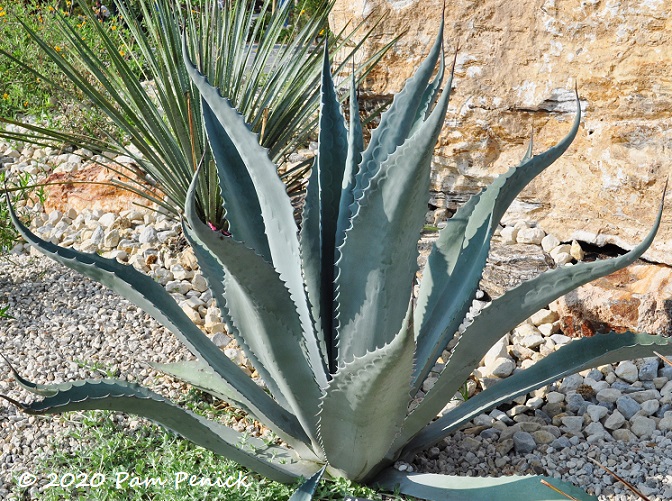
I like those sinuous leaves.
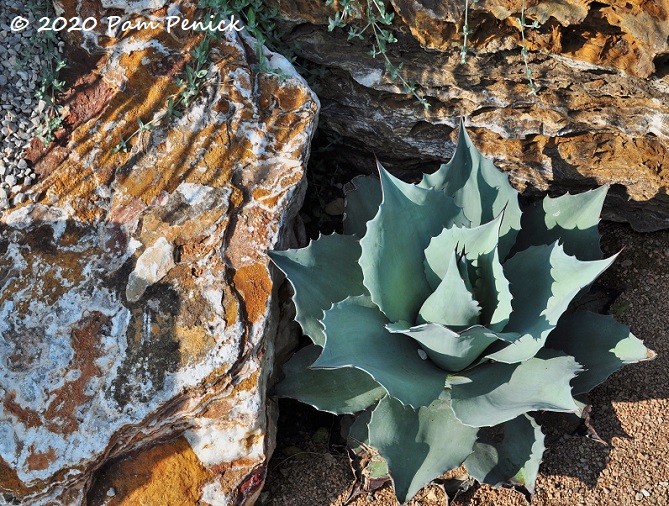
This looks like a little whale’s tongue agave, maybe.
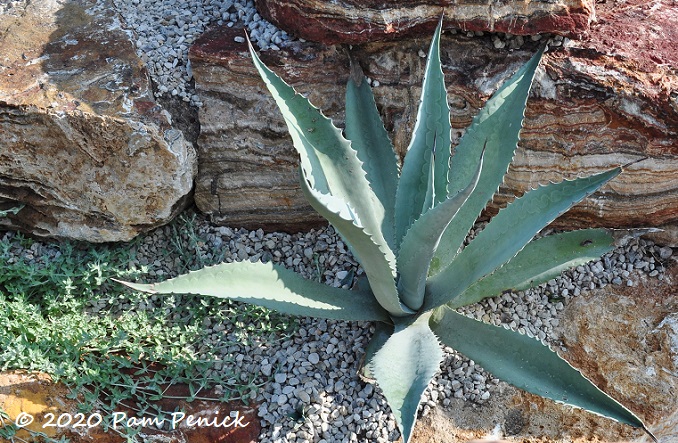
‘Silver Surfer’ agave
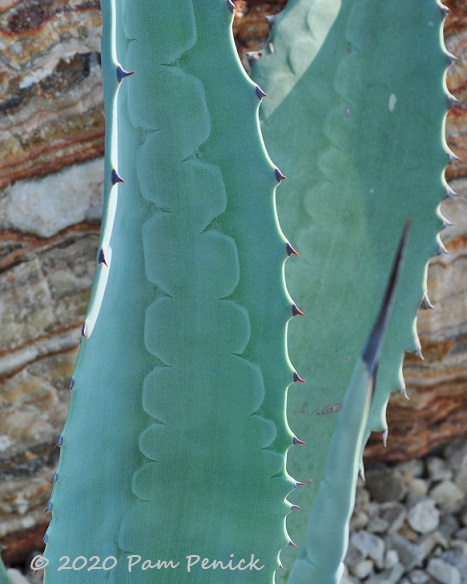
Check out these zigzagging leaf imprints, made before the leaf unfurled.
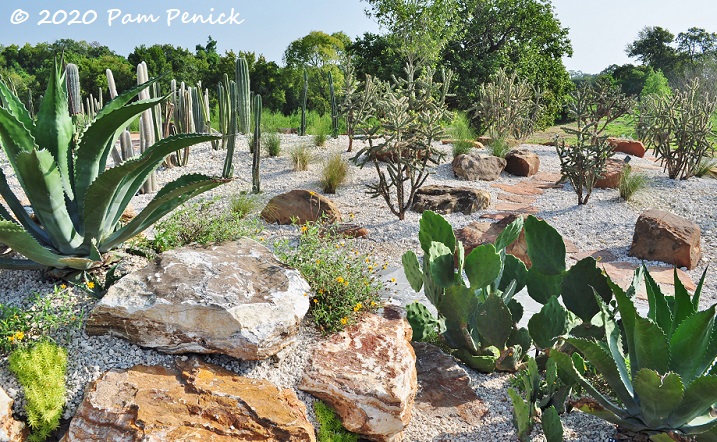
Tall cacti — cholla and wooly torch cactus — look otherworldly in a pale gravel expanse.
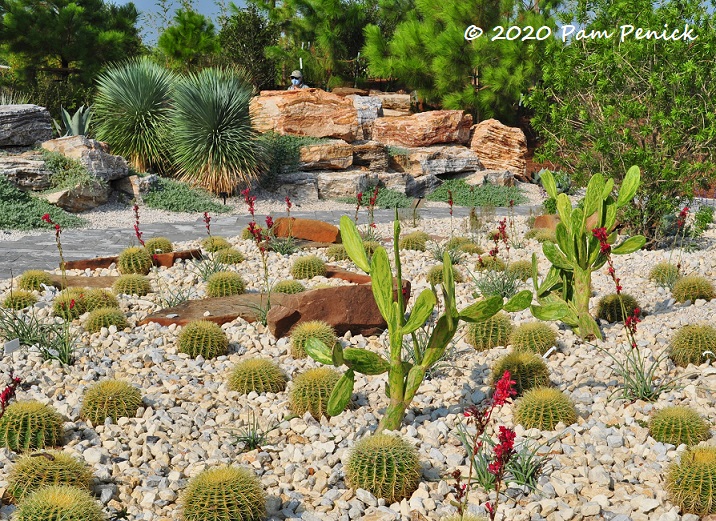
These plants are more familiar to Austin eyes: pincushion-like golden barrel cactus, ‘Brakelights’ hesperaloe, and a lime-green variegated prickly pear. Yucca rostrata‘s shimmery, spherical forms stand guard in the background.
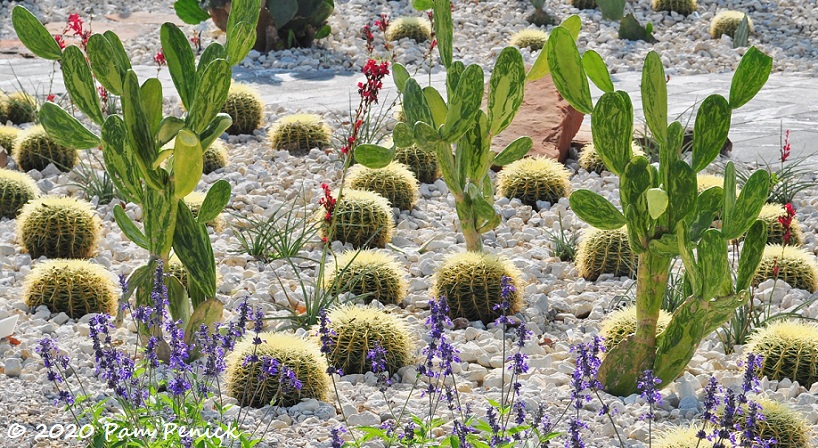
Look at that color and form!
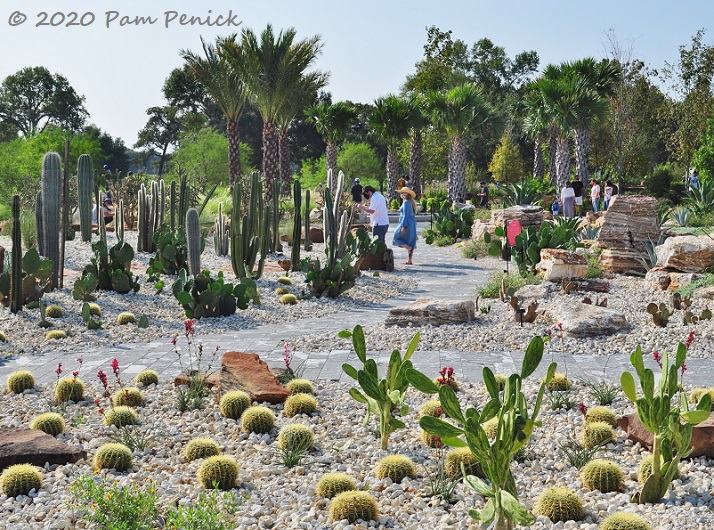
A wider view shows the palms of the savanna garden in the distance.
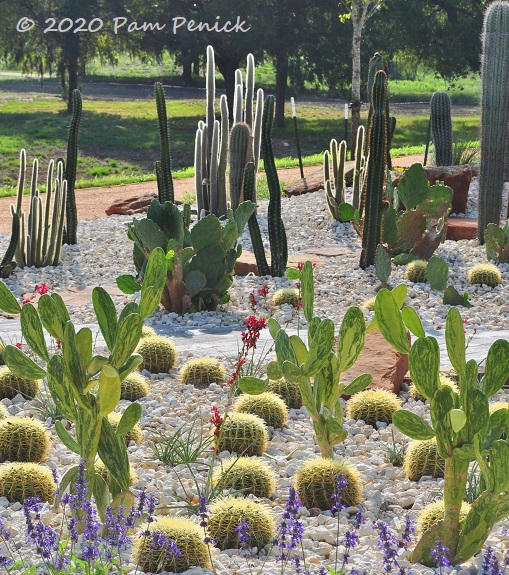
The prickly pears and golden barrels segue into the torch cactus area.
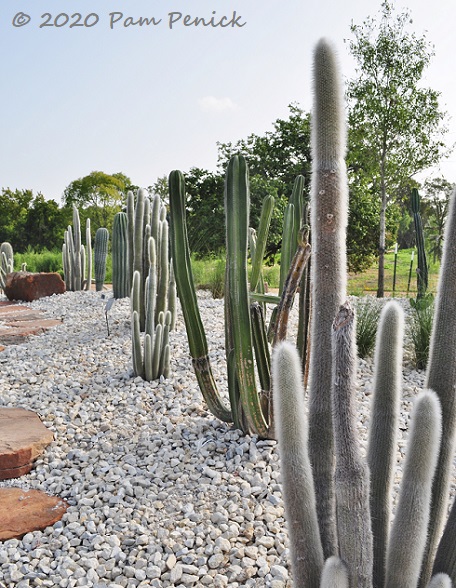
Wooly torch (Cleistocactus strausii), native to the mountains of Bolivia and Argentina, is fuzzy with white spines.
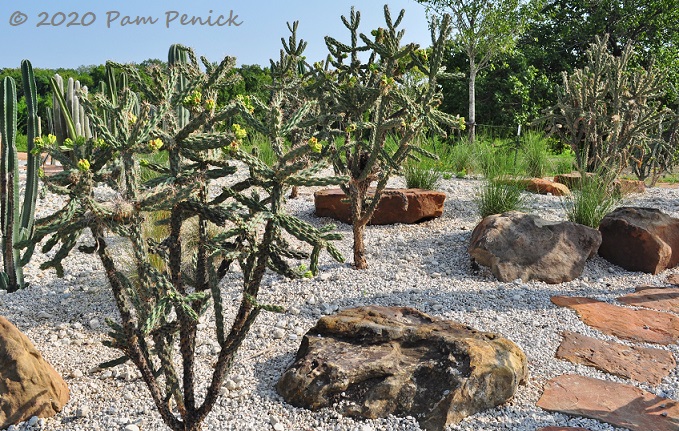
Cholla looks like a children’s building toy with its segmented, tubular stems.
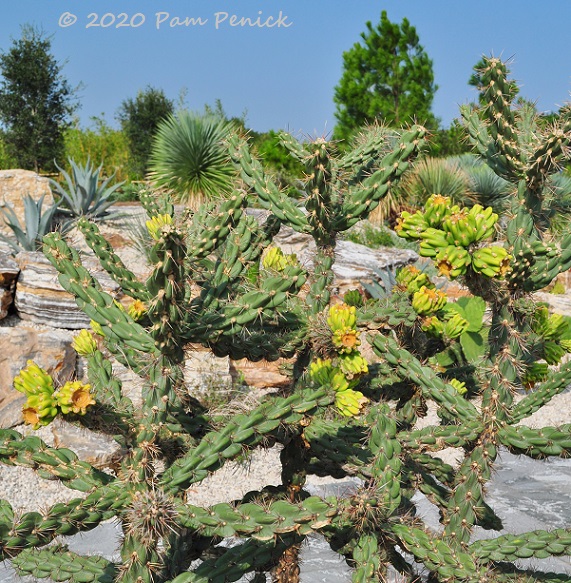
Lemon-lime cholla fruits
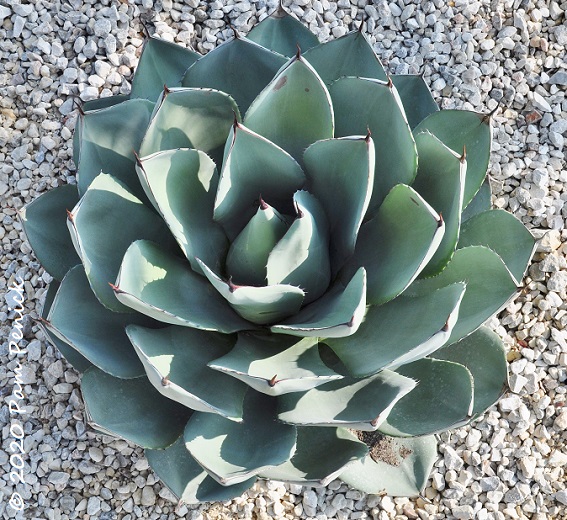
Agave symmetry gets me every time.
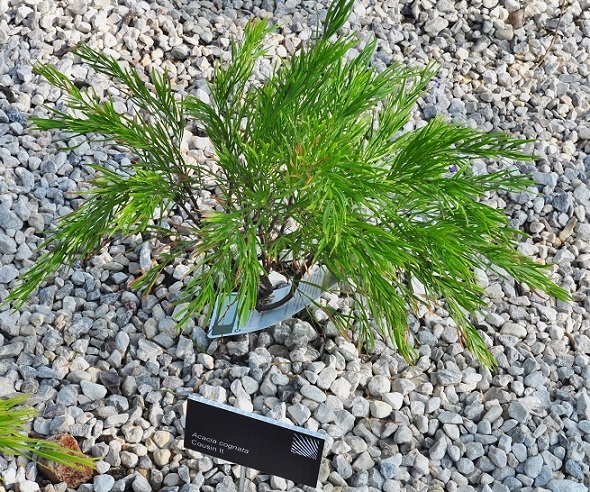
Whaaaat? A ‘Cousin Itt’ acacia? Will it grow in Texas? Jealous!!
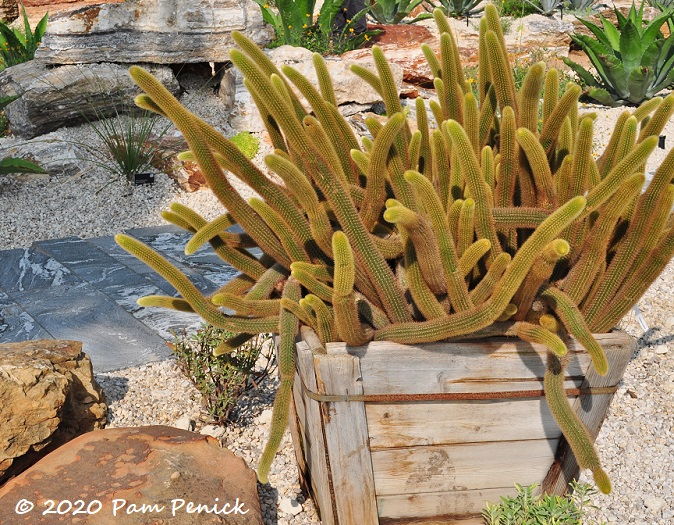
Golden rat tail cactus (Hildewintera aureispina) looks like Medusa’s hairdo.
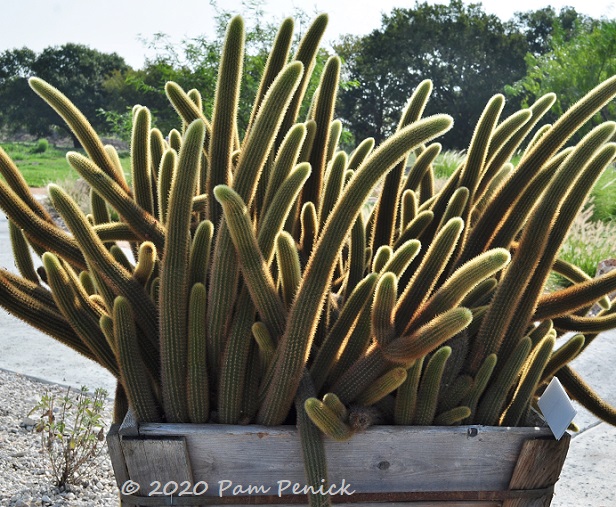
Its spines beautifully catch the light.
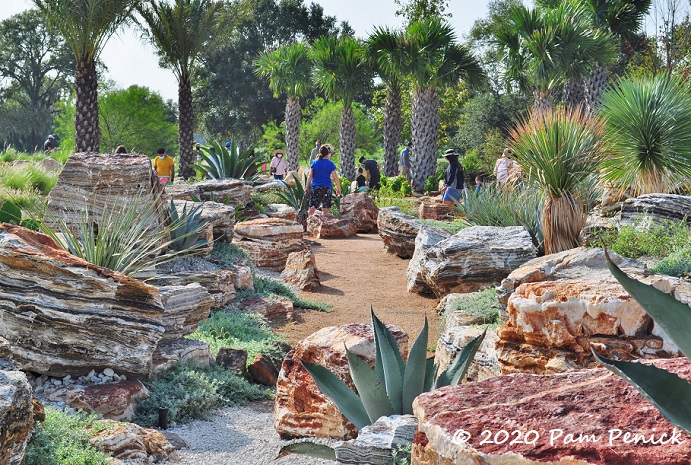
One last look at Arid Valley Desert Canyon.
Savanna
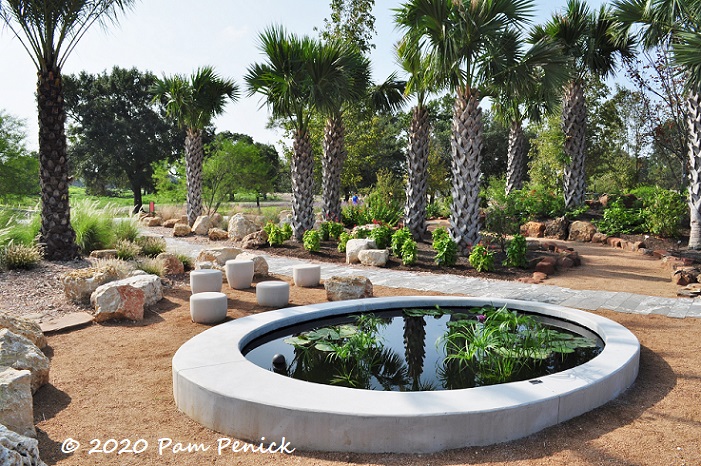
Next we explored the Savanna garden, a grassy space with an oasis of palm trees surrounding a contemporary-style oval pond.
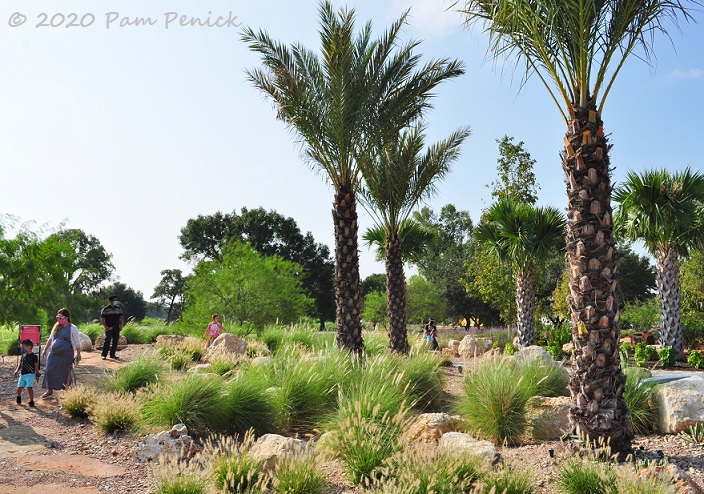
Austin has savannas too, but our grasses are smaller and the trees that edge them are typically oaks and junipers.
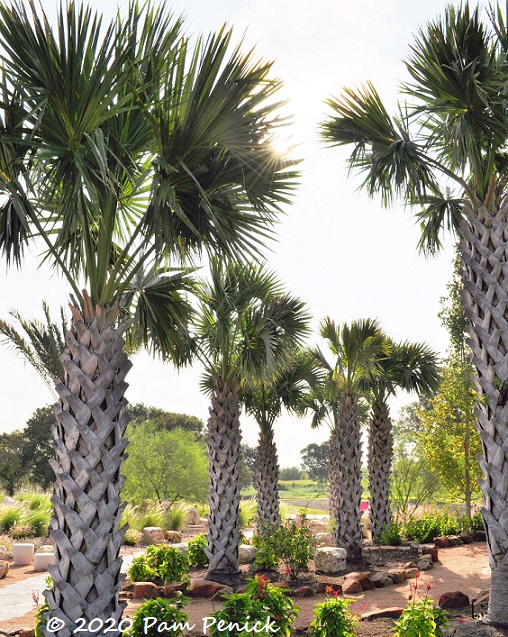
What place does this evoke for you? Northern Africa?
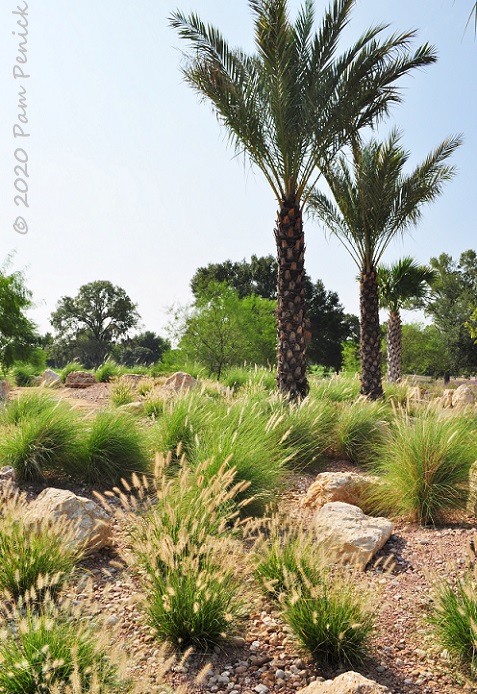
The grasses were in bloom and catching the light.
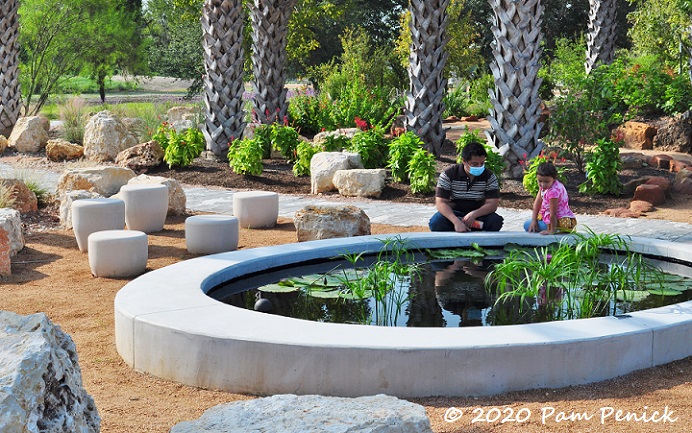
Marshmallow stools offer seating near the pond, but the raised edge is clearly the best spot.
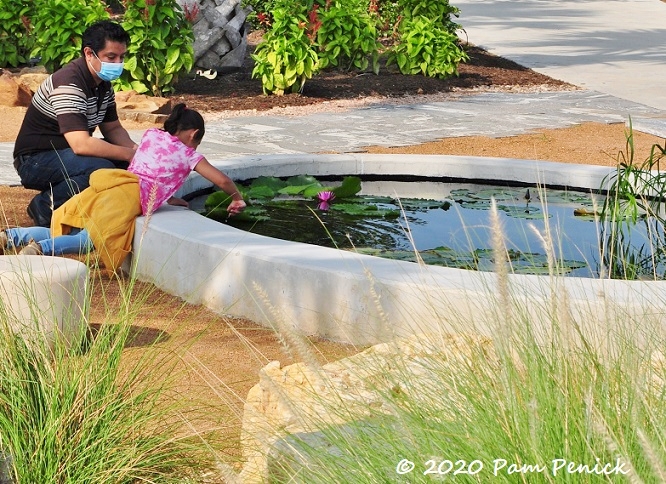
Water is a magnet in a garden.
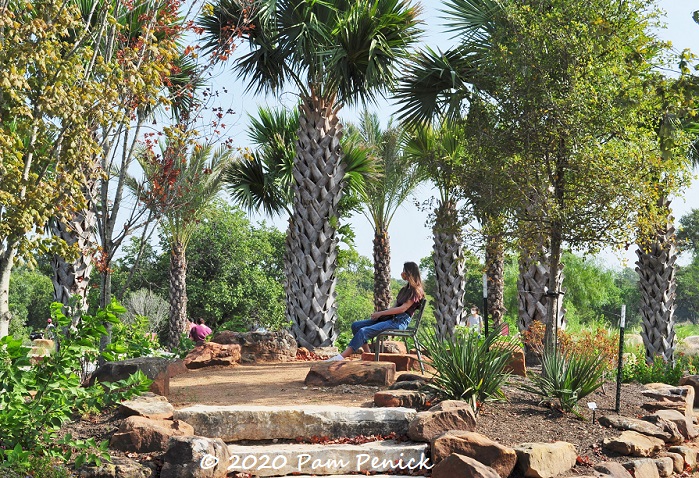
A couple of chairs in a gravel patio atop a low hill offer a perfect spot to sit like Simba and survey the Pride Lands.
Pollinator Garden
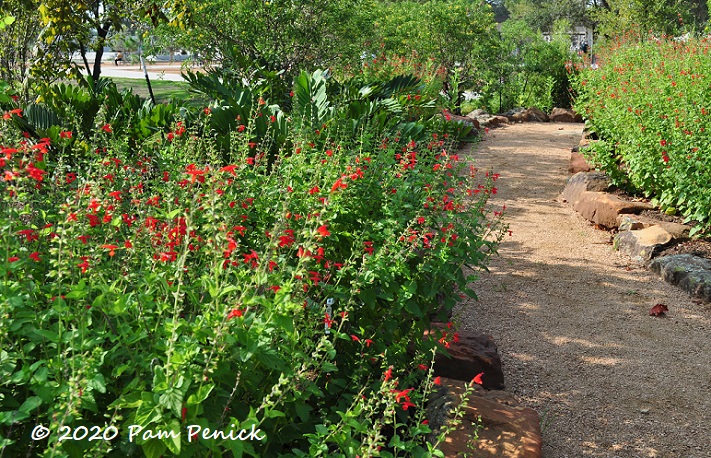
Heading back we came across the Pollinator Garden, where red salvias and other flowering plants tempt hummingbirds, bees, and butterflies.
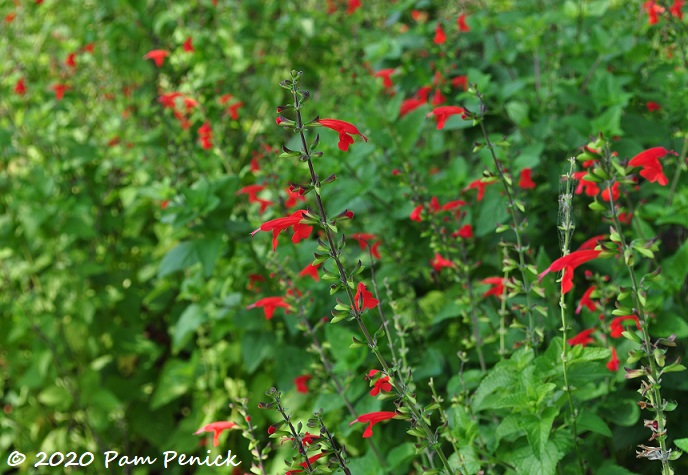
Bright red flowers are hummingbird bait.
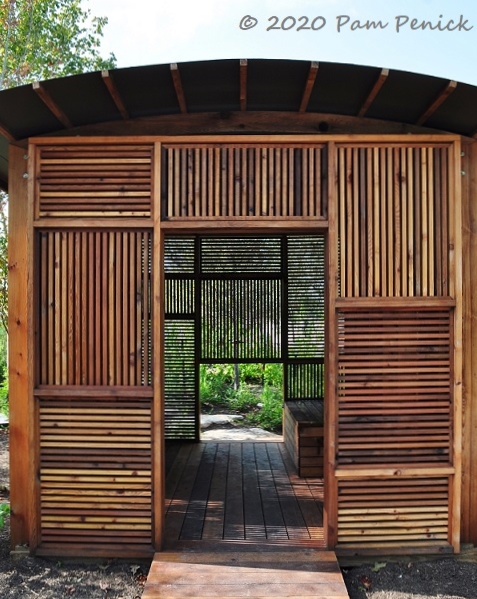
Here’s another curiosity cabinet, like the one I showed in Part 1, only this one has a path leading out from the kid-sized door in back. Eventually these open-air buildings will contain items meant to be touched and explored. But perhaps that must wait until after covid-times.
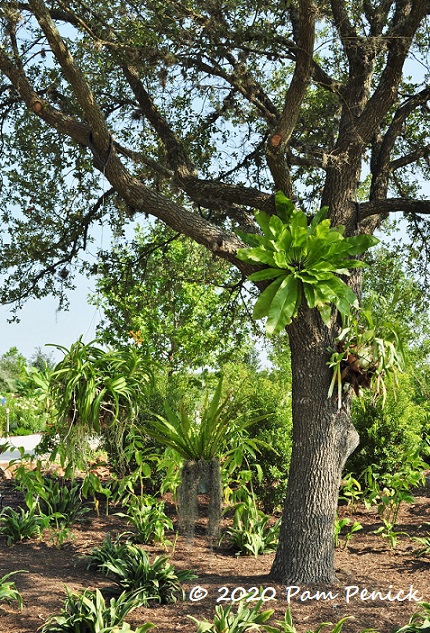
Tucked in the fork of a tree trunk and suspended from branches, epiphytic plants look like tree jewelry.
Culinary Garden
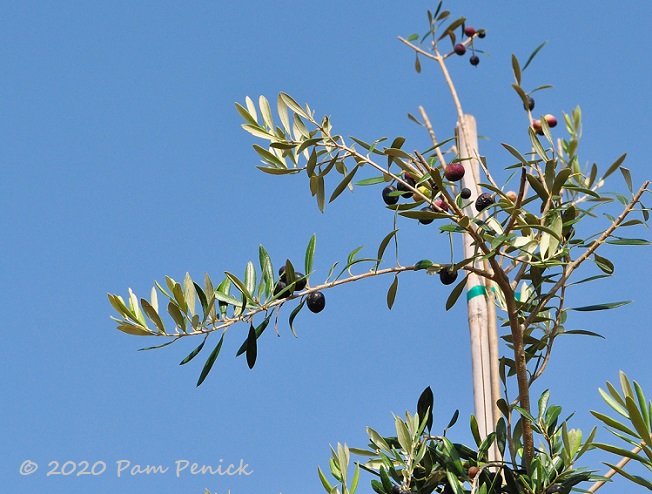
Back at the entrance we investigated the Culinary Garden’s edibles, including olive trees producing fruit.
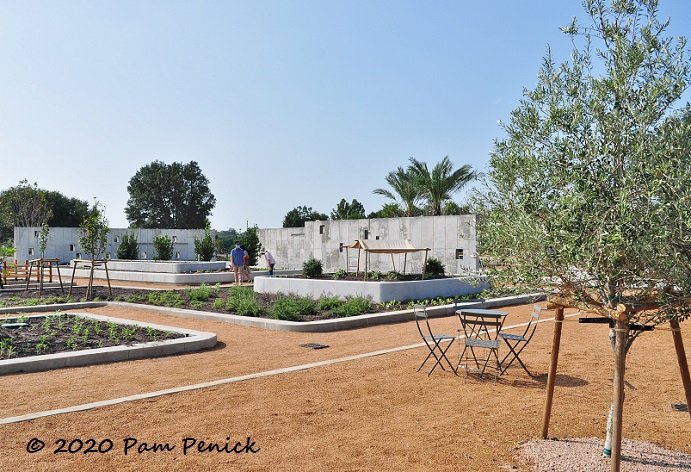
Rectangular beds feature “edible and medicinal plants — many of which visitors could grow in their own yards — that have served as a basis for economic and cultural exchange across the history of the world.” Beyond, a “water wall,” slated to open in December, is under construction. This and other garden spaces still to come are reason enough to return soon for another visit. Lucky Houstonians to have this in their backyard!
I hope you’ve enjoyed the opening-weekend tour. For a look back at Part 1 of my visit to Houston Botanic Garden, click here.
__________________________
Digging Deeper
Come learn about gardening and design at Garden Spark! I organize in-person talks by inspiring designers, landscape architects, authors, and gardeners a few times a year in Austin. These are limited-attendance events that sell out quickly, so join the Garden Spark email list to be notified in advance; simply click this link and ask to be added. Season 8 kicks off in fall 2024. Stay tuned for more info!
All material © 2025 by Pam Penick for Digging. Unauthorized reproduction prohibited.


Well that desert garden/canyon was lovely. Fifty inches of rain huh? Wow. It will be interesting to see how those plants do long term (please go back!). So that rattail cactus in the crate, are they leaving it planted like that do you think?
Yeah, 50 inches that can come in the form of rain bombs that cause widespread flooding. I’d love to hear from the garden about how they’ve planned for flooding events, not only for the cactus garden but the garden as a whole. It’s something everyone in Houston (and Austin, aka Flash Flood Alley) has to think about.
I kind of feel like that rat tail cactus will be going in the ground or a different container. It looked like a grower’s container, although I didn’t hate it.
That’s a pretty impressive cactus / succulent garden, especially for Houston. The other areas you reviewed are also very nice.
My husband and I have cactus and succulents, but they are all in pots and go inside when a freeze threatens. I am looking forward to seeing how the ones planted in this botanical garden fare. We are in the same general area as the garden, just a little bit south of it, in Clear Lake City. I have wanted, for a long time, a cactus / succulent front yard, but our HOA is one of those powerful ones and frowns on gravel yards. I know the American Agave grows well here. In our old house, there was one planted in the yard of the house next door. It wasn’t raised or anything. After many years, it finally bloomed and died. I have also seen them around other yards here, so, evidently, that particular species of agave does okay with our humidity and rainfall, surviving high-water events also. I hope they put in more succulents. One of ours that seems to do well here is the Ghost Plant, Graptopetalum paraguayense, probably one of the easiest succulents to grow. Ours are in pots, which I filled with a handmade succulent ‘soil’ – they come in when it is frosty. I am wondering how they would do in a raised, well-drained bed here. My favorite cactus is the Golden Barrel – we have two, in pots. Again, I wonder how they will do in the ground here.
Thank you, again, for this review. I have wondered for many years why Houston did not have the gardens you see in so many other places. I hope this one will rectify that!
Ghost plant will do fine in the ground if given good drainage, Nancy. And in my Austin garden I never bring it indoors in winter, even the ones in pots, and it over-winters just fine. Same with golden barrel, at least those in the ground. I have a potted one that I bring inside for hard freezes, but I bet you wouldn’t need to worry about that in zone 9.
The Arid Valley/Desert Canyon garden is very well done. I couldn’t help but compare it to my local botanic garden’s desert garden area, which shows none of HBG’s finesse when in comes to presenting plants in the best possible light.
HBG has done a fine job indeed. I look forward to seeing it again once it’s filled in a little more.
Really enjoyed this visit with you, Pam — thanks so much! Who knows, botanic gardens may be poised to become the next big thing now that outdoor activities are what we need for the foreseeable future.
I think you’re right, Denise. We’re all outside a lot more now, even in hot, steamy Texas. In fact I’m lobbying my husband about adding a roof over a patio at our house since that’s the only place we’re visiting with our adult son right now.
Thank you, Pam, for a perfect view of HBG! I can’t wait to go back this weekend!
Have fun in the garden!
You did an amazing job capturing our nascent botanic garden. Let me know next time you come, I’m friend with some staff there and the landscaper doing the plants installations.
Oh, how cool! And lucky you to be able to visit often!
Oh those big rocks are beautiful
They really are. So colorful!
These gardens are super impressive. They’re done with much Houston elan. And again your photos are fantastic Pam. Makes me eager to visit. How nice the temp was so mild during their opening weekend.
The desert garden is a real curiosity to know how it will fare over time. Kinda the flip side of overly irrigated parts of Phoenix that are surreally green. Instead Houston surreally brown ha. If they can pull this off and successfully grow cactus etc outside of our own zones up here I’ll be quite envious.
Surreally brown — hah, I enjoyed that comparison! I know what you mean about potential garden envy. I’m always envious of those PNW gardeners who can pull off not only the lush look but also the spiky desert look. Not fair! 😉
I know, the PNW folks are obviously in the sweet spot of both worlds!
Just catching up on your posts. After residing in Houston for 16+ years, I’m so happy to see that the Bayou City now has its own botanic garden! Previously one had to drive a long distance north in Harris County to Mercer Arboretum & Botanic Garden in Humble, TX to see gorgeous plantings.
Are all the plants identified by signs? I’m a big fan of good signage since, for me, that’s the only way to really learn and expand my plant knowledge. There’s nothing more frustrating than going to a botanical garden and having only a few species identified.
Thanks for sharing your visits there.
I do recall there were lots of plant label signs. I have mixed feelings about labels myself. As a garden photojournalist, I appreciate labels so I can share accurate plant names on my blog. But from a design standpoint, and as a photographer trying to get great shots, I hate plant labels. They always get in the way of the scene itself. So it’s a love-hate thing for me. 🙂
There’s a lot to admire in these shots. My fav is the savanna garden palms rising in the background of the arid garden – it feels oddly Jurassic somehow! 50 inches of rain a year… wow. I think the cleistocactus will be ok as long as water can drain away from the roots (which looks like it was the case). How old is this portion of the garden? Looks new but some of the plants look to have been in the ground for more than a few seasons.
I believe that planting started last fall and continued through this summer — probably right up until opening. 🙂 But that’s just my impression from following their social media. If anyone reading this knows for sure, please chime in!